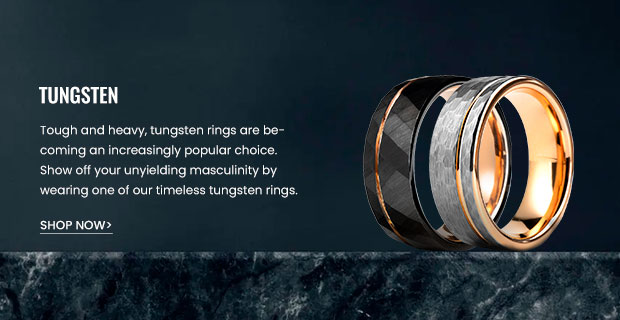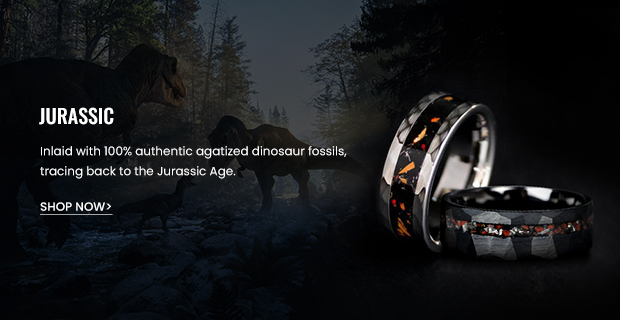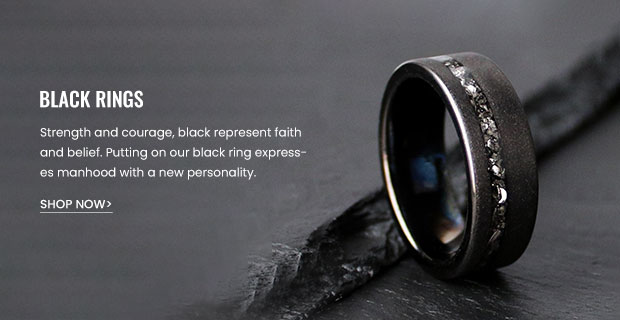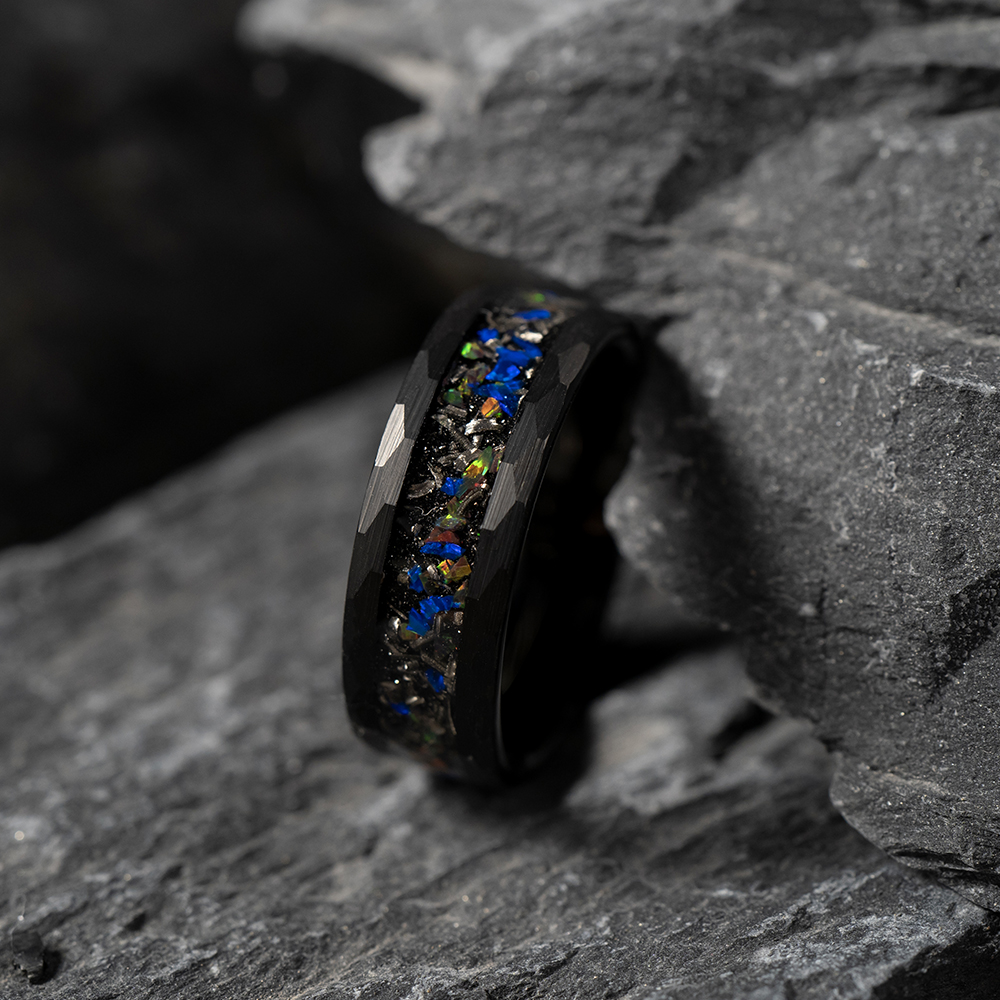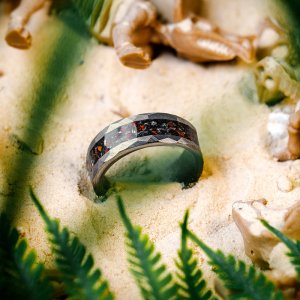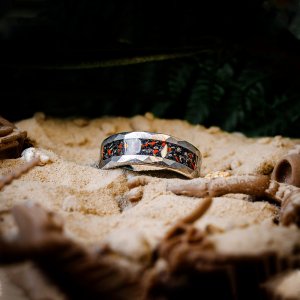How much is a meteorite worth? Let’s find out. We spend endless amounts of time and money to find jewelry pieces or an iron meteorite that truly complement our personalities. All kinds of customization and engravings can still have an element of uniformity. Meteorite rings are truly one-of-a-kind because of their unique Widmanstätten Pattern.
With growing popularity, the question of the lunar meteorite’s deeper value is also rising. Sure, meteorites are as scarce as it gets, and the good ones aren’t easy to get your hands on.
But exactly how much should you expect to pay for them? What about meteorite worth? And will they carry the same value in the long run? Read on to learn all about meteorite rings and their unshakeable monetary and sentimental value.
Meteorite History: Understanding the Basics
Space rocks from various celestial bodies or the solar system hit the earth all the time. Meteorites are some of the oldest existing space rocks from the ancient era. We can take the example of a stony meteorite.
Even today, space rock hits the earth occasionally and creates bright streaks of light famously known as the “shooting stars.”
Meteorites usually originate from fascinating and far away celestial bodies like the moon, grand rapids and planet mars. They finally hit earth after traveling for millions of years in space, where they form beautiful crystalline patterns on their bodies.
The oldest kind of meteorite— carbonaceous chondrites is dated at 4.56 billion years old, resulting from a meteor crater. And Washington university even conducted research on it.
While meteorite jewelry is believed to be a new craze rooted in modern preferences, it was also popular among ancient civilizations. One can find the examples in smithsonian museum.
Ancient Egyptians used to embed meteorites in decorative objects and jewelry as they symbolized strength and purity. The oldest meteorite jewelry was discovered inside a 5000-year-old Egyptian tomb in Cairo. It is believed that the meteorite bead was crafted between 3,350 and 3,600 BCE.
Many more ancient pieces of meteorite jewelry have since been found, giving meteorite rings a beautiful backstory to tell everyone.
How Valuable Are Meteorites?
A meteorite’s worth lies in multiple aspects, including its origin, content, and age. Among the already scarce meteorites, there are further classifications.
Some overly scarce meteorites, such as the Winchcombe meteorite, are incredibly valuable and can cost more than diamonds. One rare piece of 1.7g Winchcombe meteorite is currently valued at $12,600.
An average of 3000 tons of gold is mined every year. In contrast, it is estimated that an average of just 7.9 meteor falls are reported each year. Discoverability of fallen meteorites is another rare occasion. This makes them more scarce compared to gold and some types of diamonds. However, monetary value still varies greatly. Despite the scarcity, meteorites can be purchased for a considerably lower price.
The state of meteorite also plays a role. A common meteorite in its raw form will have a modest price compared to a finished, etched, and well-polished one.
When it comes to the value of meteorites that are used in jewelry, it can be a whole different topic. The visually-pleasant colors, contrasts, inclusions, and patterns are more in demand for jewelry.
Such qualities are also harder to get your hands on— grey, bumpy, or dull meteorites are more common. This only makes the rarer side of meteorites— Gibeon, Lunar, and Martian meteorites highly valuable because of their brighter and more pronounced geometric texture.
Falls Versus Finds
For many years, the difference between meteorite “falls” and meteorite “finds” has been of great importance. Not to just people buying jewelry but also scientists enticed by the varying chemical compositions.
In the simplest terms, “Falls” are meteorite rocks that are observed in the sky by some people or cameras. When their trajectory and beam of light are successfully followed and new rock is discovered, it can gather more attention and value.
“Finds” are meteorites that are discovered many years after their first fall and can be as old as billions of years.
Scientifically and even aesthetically, “falls” are more valuable and highly sought-after. This is because years of pressure and being buried under the earth’s layers for thousands of years can degrade the “finds” meteorites.
Their authenticity is also harder to trace as the chemical composition, texture, and inclusions can become diluted. The years of pressure and heat can also modify their overall chemical structure, making them less valuable.
Falls have a relatively undisrupted build and a more pronounced Widmanstätten pattern. Their crystalline structure and inclusions are also untouched, making the appearance more vibrant and speckled.
However, only a tiny fraction of meteorite collection has been traced to falls, 1.8% worldwide.
Types of Meteorite
Although there are hundreds of different classifications, meteorites are usually divided into three main subgroups. These include the Irons, Stones, and Stoney-iron compositions.
Iron Meteorites
Most iron meteorites are made of 95% iron and 5% nickel and other inclusions. Because Iron and nickel are what form the core of most planets, iron meteorites originate from just that. These were once part of a previously existing plant’s core or an asteroid that no longer exists.
Stone Meteorites
Stone meteorites form the second largest group of meteorites. They were once part of a now-gone planet’s crust. After traveling for billions of years and colliding with various elements, they form a highly speckled and diverse composition. They formed highly distinct patterns as their bodies grabbed onto different celestial debris. This is what makes stone meteorites aesthetically pleasant— the tiny inclusions of sparkly stones give off a more distinguished look to jewelry.
Stoney-Iron Meteorites
These only make up 1 to 2% of the overall meteorite collection, making them extremely rare. They have the elements and visual qualities of both Iron and Stone meteorites.
Stoney-iron meteorites are famous for the unique matrix pattern they form, along with a sparkly contrast. Among the classification, there are two subgroups— Pallasites and the Mesosiderites.
Pallasites are one of the most alluring meteorites and create vibrant, random crystalline patterns. The tiny speckles of olivine crystals among the nick-iron matrix make them an incredible find for jewelry. Their green color is one of the rarest among the mostly grey and silver meteorites.
Meteorite Jewelry Factors
Meteorites have become a popular choice of focal point when it comes to buying high-stake jewelry for special events. They make sentimental purchases for both self-indulgence purchases and gifts. Because of their outer space origins and a sterling backstory, they are increasingly being picked for engagement and wedding rings.
If you are trying to make all the right decisions with a meteorite ring purchase without losing your mind, consider the following buying factors.
Type of Meteorite
We have only discussed a tiny fraction of the types of meteorites that exist out there. There are Gibeon, Lunar, Martian, Secyhman, Muonionalusta, Chrondites, and many more to choose from.
Not to mention the further sub-groups that exist for each type. Every meteorite has its own origin story and chemical composition.
If your purchase is sentimental to you, it would be worth the time to learn about these factors. Picking the right meteorite can leave you with a good backstory to tell your friends and family about your wedding/engagement ring purchase.
Types of Designs
When it comes to meteorite ring designs, the choices are truly endless. There are many ways a meteorite can be incorporated within a ring.
Some feature an all-meteorite exterior and base, while others have a contrasting inlay. Knowing about the colors and contrasts available out there can help immensely.
The Thiaoouba Ring is a stunning example of how much can be incorporated into just one ring. It features a simulated silver meteorite along with a whiskey barrel inlay.
The overall design is further accentuated with rose gold tungsten, creating a classy and well-balanced appearance.
Paired Metal
Most meteorite rings will have a base of metal rather than a pure meteorite build. This is helpful both aesthetically and also when it comes to maintenance and comfort.
A smarter choice is a smoother and texture-free base of a metal such as gold, tungsten, or titanium. The choice of your metal will also help you accentuate the contrast and maintain the meteorite as the focal point.
The Blue Moon Ring is a good example of a powerful contrast. The ring incorporates an inlay of sparkly blue opal meteorite against deep black carbide tungsten. The subtle and matte tungsten allows the meteorite’s sparkle to take the spotlight.
Interested in Meteorite Jewelry?
Looking for a reliable vendor but can’t seem to find one? We know someone you can trust. However, we still encourage you to do your own research, explore different options, and go with your intuition.
Men’s wedding Bands is one of the most credible and oldest meteorite rings brands. We trust and believe in their service because of the thousands of positive reviews we have observed from their customers over the years.
Our meteorite rings accompany exceptional longevity, high-quality finishes, and premium meteorite stones. Best of all, they promise 100% degradation-free rings and generous warranties if something doesn’t go as planned.

